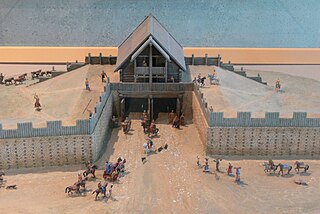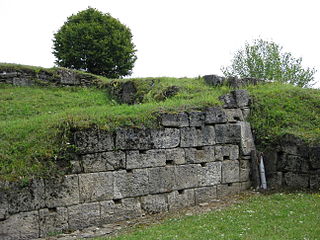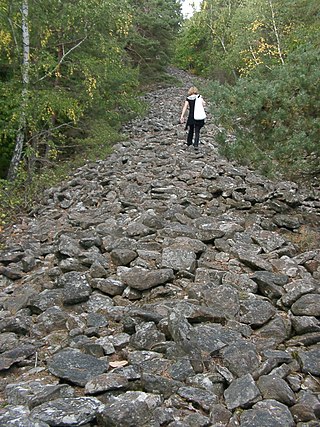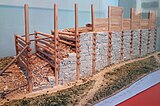
The La Tène culture was a European Iron Age culture. It developed and flourished during the late Iron Age, succeeding the early Iron Age Hallstatt culture without any definite cultural break, under considerable Mediterranean influence from the Greeks in pre-Roman Gaul, the Etruscans, and the Golasecca culture, but whose artistic style nevertheless did not depend on those Mediterranean influences.

A hillfort is a type of earthwork used as a fortified refuge or defended settlement, located to exploit a rise in elevation for defensive advantage. They are typically European and of the Bronze Age or Iron Age. Some were used in the post-Roman period. The fortification usually follows the contours of a hill and consists of one or more lines of earthworks, with stockades or defensive walls, and external ditches.

A fortification is a military construction or building designed for the defense of territories in warfare, and is also used to establish rule in a region during peacetime. The term is derived from Latin fortis ("strong") and facere.

An oppidum is a large fortified Iron Age settlement or town. Oppida are primarily associated with the Celtic late La Tène culture, emerging during the 2nd and 1st centuries BC, spread across Europe, stretching from Britain and Iberia in the west to the edge of the Hungarian plain in the east. These settlements continued to be used until the Romans conquered Southern and Western Europe. Many subsequently became Roman-era towns and cities, whilst others were abandoned. In regions north of the rivers Danube and Rhine, such as most of Germania, where the populations remained independent from Rome, oppida continued to be used into the 1st century AD.

Bibracte, a Gallic oppidum or fortified settlement, was the capital of the Aedui and one of the most important hillforts in Gaul. It was situated near modern Autun in Burgundy, France. The material culture of the Aedui corresponded to the Late Iron Age La Tène culture.

Kelheim is a town and municipality in Bavaria, Germany. It is the capital of the district Kelheim and is situated at the confluence of the rivers Altmühl and Danube. Kelheim has a population of around 16,750 (2020).

Alcimoennis or Alkimoennis is the name widely attached to a Celtic Oppidum, or hill fort above the modern town of Kelheim in Bavaria, Germany. The name comes from Ptolemy, who in his Geography, only mentioned the name and described the location of the settlement. There is some controversy over the identification of the Kelheim remains with Alcimoennis, but it is still widely accepted.

The Oppidum of Manching was a large Celtic proto-urban or city-like settlement at modern-day Manching, near Ingolstadt, in Bavaria, Germany. The Iron Age town was founded in the 3rd century BC and existed until c. 50-30 BC. It reached its largest extent during the late La Tène period, when it had a size of 380 hectares. At that time, 5,000 to 10,000 people lived within its 7.2 km walls. Thus, the Manching oppidum was one of the largest settlements north of the Alps. The ancient name of the site is unknown, but it is assumed that it was the central site of the Celtic Vindelici tribe.

Murus Dacicus is a construction method for defensive walls and fortifications developed in ancient Dacia sometime before the Roman conquest. It is a mix between traditional construction methods particular to Dacian builders and methods imported from Greek and Roman architecture and masonry, and – although somewhat similar construction techniques were used before, during and long after the period – it has peculiarities that make it unique.

The Glauberg is a Celtic hillfort or oppidum in Hesse, Germany consisting of a fortified settlement and several burial mounds, "a princely seat of the late Hallstatt and early La Tène periods." Archaeological discoveries in the 1990s place the site among the most important early Celtic centres in Europe. It provides unprecedented evidence on Celtic burial, sculpture and monumental architecture.

Alesia was the capital of the Mandubii, one of the Gallic tribes allied with the Aedui. The Celtic oppidum was conquered by Julius Caesar during the Gallic Wars and afterwards became a Gallo-Roman town. Modern understanding of its location was controversial for a long time; however, it is now thought to have been located on Mont-Auxois, near Alise-Sainte-Reine in Burgundy, France.

The Ipf is a primarily treeless mountain, near Bopfingen, Ostalbkreis, Baden-Württemberg, Germany, with a prehistoric hill fort on its top.

Murus gallicus or Gallic wall is a method of construction of defensive walls used to protect Iron Age hillforts and oppida of the La Tene period in Western Europe.

The Vix Grave is a burial mound near the village of Vix in northern Burgundy. The broader site is a prehistoric Celtic complex from the Late Hallstatt and Early La Tène periods, consisting of a fortified settlement and several burial mounds.

Titelberg is the site of a large Celtic settlement or oppidum in the extreme south west of Luxembourg. In the 1st century BCE, this thriving community was probably the capital of the Treveri people. The site thus provides telling evidence of urban civilization in the century before the Roman conquest.

Basel-Münsterhügel is the site of an Iron Age fort or oppidum, known as Basel oppidum, constructed by the Gaulish Rauraci after the battle of Bibracte in 58 BC. It the site of Basel Minster, in the Swiss city of Basel.
Hillforts in Britain refers to the various hillforts within the island of Great Britain. Although the earliest such constructs fitting this description come from the Neolithic British Isles, with a few also dating to later Bronze Age Britain, British hillforts were primarily constructed during the British Iron Age. Some of these were apparently abandoned in the southern areas that were a part of Roman Britain, although at the same time, those areas of northern Britain that remained free from Roman occupation saw an increase in their construction. Some hillforts were reused in the Early Middle Ages, and in some rarer cases, into the Later Medieval period as well. By the early modern period, these had essentially all been abandoned, with many being excavated by archaeologists in the nineteenth century onward.

Vertillum is a Gallo-Roman site in the modern commune of Vertault in the Côte-d'Or department of eastern France. It has been extensively excavated over the past century. Many of the objects found at the site are held in the nearby Musée du Pays Châtillonnais.

The Heidenmauer near the Palatine county town of Bad Dürkheim in the German state of Rhineland-Palatinate is a circular rampart or ringwork, two and a half kilometres long, which was built by the Celts around 500 B. C. as a type of Murus Gallicus but was pulled down again not long afterwards. The wooden elements of the wall have disappeared over the course of time by rotting away, but the stones have survived.

In fortification architecture, a bank or rampart is a length of embankment or wall forming part of the defensive boundary of a castle, hillfort, settlement or other fortified site. It is usually broad-topped and made of excavated earth and/or masonry.






















